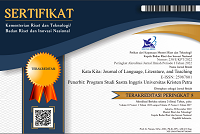Multimodal Analysis of People’s Hectic Life in Apple Advertisement The Whole Working From Home Thing
(1) Petra Christian University
(2) Petra Christian University
(*) Corresponding Author
Abstract
Keywords
Full Text:
PDFReferences
Chia, A. & Chan, C. .(2017). Re-defining ‘reading’ in the 21st century: Accessing multimodal
text. Beyond Words: A Journal on Applied Linguistics and Language Education, 5(2),
-105. https://doi.org/10.33508/bw.v5i2.1590
Danesi, M. (2004). Message, signs, and meanings. A basic textbook in semiotics and
communication. (3rd ed.). Canada Scholars’ Press Inc.
Eiseman, L. (2017). The complete color harmony: Pantone edition. Rockport Publishers.
Ekman, P., & Friesen, W. V. (2003). Unmasking the face: Malor Books.
Mercado, G. (2011). The filmmaker's eye: Learning (and breaking) the rules of cinematic
composition. Elsevier.
Paltridge, B. (2012). Discourse analysis: An introduction (2nd ed.). Bloomsbury.
Pease, A., & Pease, B. (2004). The definitive book of body language. Pease International.
DOI: https://doi.org/10.9744/katakita.10.3.407-415
Refbacks
- There are currently no refbacks.
Supported by:
Indexed in:
Tools:
Stats (installed since 17 December 2018)
View My Stats













